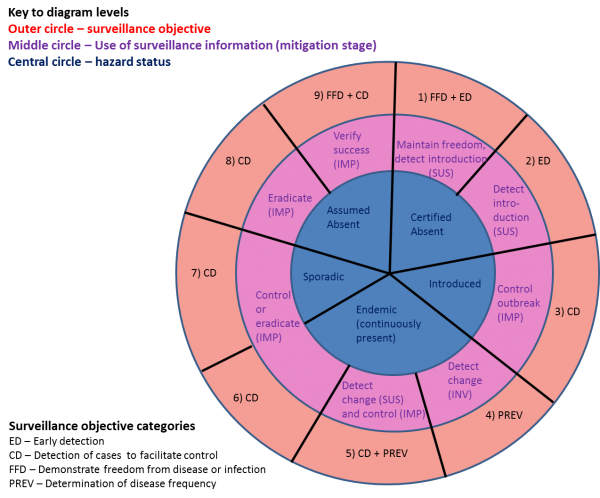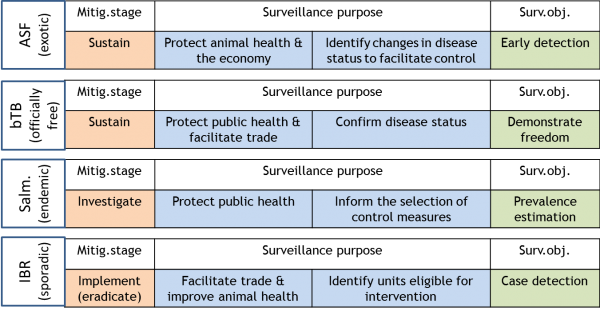Table of Contents
A surveillance system is defined here as a collection of various surveillance components which are all aimed at “describing health-hazard occurrence and contributing to the planning, implementation, and evaluation of risk-mitigation actions” (Hoinville et al., 2013), for one health-hazard in particular, and in a defined region. A surveillance system is therefore characterised by:
- One defined hazard which is targeted by surveillance (a disease or another health-threat);
- The objective of the surveillance system (the following have been identified within the RISKSUR project: case detection, prevalence estimation, demonstrate disease freedom and early detection; see details below);
- The geographical area covered by the surveillance system;
These surveillance systems are designed within a context which includes.
- The specific animal population susceptible to the hazard in the region of interest;
- Characteristics of the distribution of the hazard (or hazard risk) at the population level, herd level or animal level, which can impact the design of surveillance.
Furthermore, the surveillance system should be described with its political and economic context, which will also be detailed at this step.
Step by step surveillance design (following the structure of the RISKSUR tool):
1.1 Hazard
 General information and advice: The first step of setting up the surveillance scenario is to define the hazard against which surveillance is being designed.
General information and advice: The first step of setting up the surveillance scenario is to define the hazard against which surveillance is being designed.
Multi-hazard surveillance: Please visit the page dedicated to addressing the multi-hazard surveillance issue. Multi-hazard surveillance is defined here as surveillance activities designed to target multiple hazards at the same time (parallel design), or the secondary use of data/samples collected as part of a surveillance activity designed for one specific hazard (which we will call mother component) to investigate the presence of additional hazards (which we will call child components).
 Framework details: The framework was designed to be a generic tool, which should support the design and documentation of surveillance activities for any hazard. Therefore, the user is requested to provide the hazard name for documentation purposes, but no steps of the framework are hazard specific, that is, the steps are not adjusted to a specific hazard.
Framework details: The framework was designed to be a generic tool, which should support the design and documentation of surveillance activities for any hazard. Therefore, the user is requested to provide the hazard name for documentation purposes, but no steps of the framework are hazard specific, that is, the steps are not adjusted to a specific hazard.
 Examples available: (surveillance frameworks for EU regulated diseases will be made available when possible)
Examples available: (surveillance frameworks for EU regulated diseases will be made available when possible)
1.2 Surveillance Objective
The objective of surveillance is a key characteristic which determines the most appropriate approach for the surveillance
 General information and advice: The state of a disease in the country (or geographical area addressed) should be taken into account when deciding on the surveillance objective. Five disease states are proposed:
General information and advice: The state of a disease in the country (or geographical area addressed) should be taken into account when deciding on the surveillance objective. Five disease states are proposed:
- Believed to be absent;
- Confirmed absent;
- Endemic;
- Sporadic; and
- Recently introduced
The scheme below summarizes how the disease status and the intended use of surveillance information affects the choice of surveillance objective (IMP: Implementation, SUS: Sustainment, INV: Investigation - see Haesler et al (2011)).

According to the disease status and how surveillance information shall be used, surveillance designers should determine the main surveillance objective of the surveillance system (please refer to FAQ2.5 of the Frequently Asked Questions for details of the interpretation). Moreover, designers should think about the surveillance purpose, that is, how will the information collected in this surveillance system be used to inform policy decision (e.g. to eradicate or manage the occurrence of disease or inform trade).
 Framework details: The four main surveillance objectives around which the RISKSUR activities have been structured are:
Framework details: The four main surveillance objectives around which the RISKSUR activities have been structured are:
- Prevalence estimation: This objective is appropriate if the target hazard is (thought to be) present in the territory to be covered, and an assessment of the prevalence and or changes in prevalence over time is needed.
- Case detection: Case detection refers to the search for any animals affected, clinically or not, by the hazard under surveillance. This objective is appropriate if the hazard is present, regardless of whether the hazard occurrence is endemic, epidemic or sporadic, and action will be taken to control disease whenever it is detected.
- Early detection: This objective is appropriate for a situation where the disease is currently absent in the country or region. It may be applied to surveillance for an unknown disease or a known disease considered to pose a non-negligible risk of incursion or emergence. It may also apply to the early stages of an outbreak.
- Disease freedom: This objective is appropriate if the target hazard is thought to be absent in the territory to be covered and the aim is to demonstrate disease freedom for trade or non-trade purposes (e.g. improve public health, to decide when to stop an eradication programme and to eliminate production losses and control costs due to endemic disease). This may apply to diseases which a) have been historically absent, b) have been eradicated and official freedom has been confirmed or c) are thought to be eradicated, but official freedom has not yet been confirmed. .
Although surveillance systems may be used to provide information to address several surveillance objectives as the design of surveillance is strongly dependent on the surveillance objective we limited users to choosing only one surveillance objective for their surveillance system. This should be the primary surveillance objective. If other (secondary) surveillance objectives are relevant, the user should list that in the surveillance context information (step 1.6) and there is also an opportunity to indicate whether each of the components that contribute to the system address more than one surveillance objective in step 3.
Surveillance Purpose
Surveillance purpose has a more global meaning compared to surveillance objective. Hence, surveillance purpose should depend on the outputs needed to support decision-making and thus be policy-driven. It should describe why surveillance is necessary and how, when combined with intervention measures, it will impact on public health, animal health or the economy.
 Framework details:
Framework details:
The framework includes
- Eight categories for “what surveillance will accomplish” and
- Five categories for “why it is necessary”.
Please refer to the following examples and Section 2 of the Frequently Asked Questions developed under RISKSUR for further details. Should more than one purpose apply, please select the main purpose and document further purposes in the field “Other”.

Specific features when the disease is absent
Risk of introduction
The risk level may impact on the surveillance approaches used and the choice of surveillance components. The risk of introduction is usually estimated by means of a formal risk assessment. Please refer to the standard guidelines (e.g. OIE (2010a); OIE (2010b)) and tools to carry out a formal risk assessment:
Specific features when the objective is to demonstrate freedom from disease
Level at which freedom shall be demonstrated
Obtaining the status of freedom from disease can carry important implications for trade, but also non-trade purposes such as to decide when to stop an elimination programme. Thus, it may have relevance for a country, a zone as well as for individual herds (certification programmes).
Scenario for which freedom shall be demonstrated
The framework distinguishes between four scenarios, for which freedom shall be demonstrated:
- Achieve disease freedom after control of a disease outbreak (scenario 1)
- Achieve disease freedom after control of an endemic disease (scenario 2)
- Maintain disease freedom after eradication of a disease (scenario 3)
- Maintain disease freedom when disease has not been present for a long time (scenario 4)
A distinction between those four scenarios may impact to what extent the emphasis should be placed on components with the objective to demonstrate freedom or the objective of early detection.
- For scenarios 1 and 2, the focus lies on the risk of infection (residual undetected infection) and thus on surveys to demonstrate freedom from disease. The distinction between scenarios 1 and 2 acknowledges the fact that the pattern of residual infection may be different following eradication of a disease which was previously endemic or epidemic (outbreak).
- For scenario 3, the risk of infection (due to previously undetected infection or infection introduced since the last survey) and risk of introduction are considered, resulting in a combination of surveys to demonstrate freedom from disease and activities aimed at early detection. However, requirements for surveys to demonstrate freedom from disease are often lower compared to scenarios 1 or 2.
- For scenario 4, activities may purely focus on the risk of introduction and thus early detection, although a combination with surveys to demonstrate freedom is still done in most cases..
Please refer to the Frequently Asked Question 2.7 and Module 6 of the RISKSUR webinar series for further details.
1.3 Geographical area
Usually a country or region.
1.4 Susceptible population
 The surveillance designer should consider all the animal species susceptible to the hazard in question. This is equivalent to thinking of the target population, even if not all units can ultimately be reached by the surveillance system (actual study population). In later step of surveillance design, users will be advised to think about the specific targets for individual surveillance components – including the species and also animal production types/sectors, vectors or fomites (e.g. animal feed, environment). At this step, the designer should focus on identifying the animal species that may act as hosts.
The surveillance designer should consider all the animal species susceptible to the hazard in question. This is equivalent to thinking of the target population, even if not all units can ultimately be reached by the surveillance system (actual study population). In later step of surveillance design, users will be advised to think about the specific targets for individual surveillance components – including the species and also animal production types/sectors, vectors or fomites (e.g. animal feed, environment). At this step, the designer should focus on identifying the animal species that may act as hosts.
Susceptible species can be further differentiated according to their role in maintaining and transmitting infection (i.e. natural, aberrant and accidental hosts). Please ensure that you have sufficient background knowledge about the role of different hosts in disease transmission as that will influence the risk characteristics described below and also the choice of target population, and sampling design.
 Framework details: This information will be used later in making decisions about surveillance activities (e.g. choice of target population) and to assess the coverage of the surveillance system.
Framework details: This information will be used later in making decisions about surveillance activities (e.g. choice of target population) and to assess the coverage of the surveillance system.
1.5 Risk characteristics
 General information and advice: At this step designers should consider risk characteristics associated with the hazard distribution and the susceptible population. Risk can be non-uniformly distributed at various level, such as population (particularly geographical and temporal risk factors), herd or animal. At this step, the goal is only to list those characteristics, and identify whether they can be associated with a higher risk of hazard introduction, infection, detection, and/ or consequences.
General information and advice: At this step designers should consider risk characteristics associated with the hazard distribution and the susceptible population. Risk can be non-uniformly distributed at various level, such as population (particularly geographical and temporal risk factors), herd or animal. At this step, the goal is only to list those characteristics, and identify whether they can be associated with a higher risk of hazard introduction, infection, detection, and/ or consequences.
Definitions of levels for risk characterisation:
| Population level | | Factors influencing the risk for all herds in a specified part of the population of interest. Refers mainly to: Geographical factors: e.g. clustering of the population, areas with high trade volume (within-country, import, illegal trade, …), areas with high human population movements, factors that influence vector abundance e.g. landcover or altitude etc. Temporal risks, e.g. seasonality (population turnover, trade, hazard occurrence, vector abundance, etc) If you are not sure what population level risk factors exist and their specifics, consider performing a descriptive analysis of historic outbreak data and other epidemiological data sources (i.e. population data, movement data). |
| Herd level | | Factors influencing the risk for certain herds within the population, e.g. production type, herd size, movement history, presence of wildlife reservoirs in the geographical proximity, participation in a certification program, biosecurity status, degree of connection with other herds which can be assessed using network analysis etc |
| Animal level | | Factors influencing the risk for certain animals within herds |
Definitions for aspect of risk:
| Risk of infection | Probability of becoming infected, e.g. due to a higher probability of exposure or higher susceptibility |
| Risk of introduction | Probability of a free population becoming infected (special case of risk of infection) |
| Risk of detection | Probability of being detected by the diagnostic test applied |
| Risk of consequences | Likely magnitude of the biological and economic consequences following the event of interest |
Risk of introduction versus infection: Risk of introduction and infection are distinguished to differentiate between risk factors for (re-)incursion (relevant for early detection) and within-country spread (relevant for endemic diseases). When the surveillance goal is to demonstrate freedom from disease, only the risk of infection needs to be considered if the outcome measure is the probability of detection (surveillance sensitivity) but both the risk of infection and the risk of introduction should be considered when the outcome measure is the probability of freedom (negative predictive value).
Risk of detection refers to the ability of the observer (clinical surveillance) or diagnostic test (laboratory-based surveillance) to detect the hazard of interest. This ability may differ between subjects, e.g. due differences between subjects in expressing the outcome to be measured (e.g. clinical signs, antibodies) or the ability of the observer or diagnostic test to detect the outcome of interest if present (diagnostic sensitivity).
Examples for risk of detection are as follows:
- Older animals may be targeted for serological surveillance due to a longer period of potential exposure
- The sensitivity of clinical surveillance may differ between species due to differences in the expression of clinical signs
- Testing e.g. for tuberculosis or BSE may target older age groups as test sensitivity is insufficient to detect the agent in younger animals
Risk of consequences refers to the extent of biologic or economic consequences of a hazard occurring in a given population. Risk of consequences is important to consider
- when prioritizing/selecting a disease,
- when targeting population strata for risk-based sampling when the aim is early detection and
- for setting target probability of freedom when the aim is to demonstrate disease freedom (Cameron, A.; 2012a)
 Framework details: In later steps of the surveillance design, when these risk characteristics could be relevant to define surveillance strategies, the answers provided by the user at this step are brought back (displayed as provided by the user) and the potential for system improvement through the incorporation of risk-based strategies is pointed out to the user, along with tools and advice for the design of risk-based surveillance.
Framework details: In later steps of the surveillance design, when these risk characteristics could be relevant to define surveillance strategies, the answers provided by the user at this step are brought back (displayed as provided by the user) and the potential for system improvement through the incorporation of risk-based strategies is pointed out to the user, along with tools and advice for the design of risk-based surveillance.
1.6 Review and surveillance context
 General information and advice: At this step the surveillance designer should review the surveillance system described so far, as the next step will start listing the surveillance components. This is also the right time to characterize the surveillance context, considering factors such as:
General information and advice: At this step the surveillance designer should review the surveillance system described so far, as the next step will start listing the surveillance components. This is also the right time to characterize the surveillance context, considering factors such as:
- Legal requirements to conduct surveillance;
- Economic impact associated with the hazard;
- Disease control actions as a result of surveillance and results that would trigger those actions;
- Institutions and person responsible for the surveillance system.
 Framework details: For designers using the RISKSUR framework, the answers provided in previous steps will be displayed in one screen, to give them the chance of reviewing the system overview. Additional questions (free-text answers) help the user detailing the contextual information listed above.
Framework details: For designers using the RISKSUR framework, the answers provided in previous steps will be displayed in one screen, to give them the chance of reviewing the system overview. Additional questions (free-text answers) help the user detailing the contextual information listed above.
Please note that it is not possible to link documents to your answers, but where previous documentation exist - for instance a report submitted to the OIE and a recognition of disease freedom status - these documents can be referred to nominally in this documentation section, and these documents should then be saved in the same folder where the surveillance design outputs (Excel and/or PDF report) are saved, for future reference.











